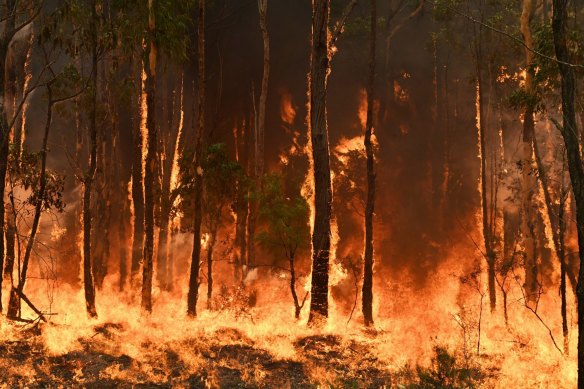BMP Insights: Key Components and Benefits of a Bushfire Management Plan
BMP Insights: Key Components and Benefits of a Bushfire Management Plan
Blog Article
Necessary Tips for Bushfire Management to Make Sure Fire Defense

Recognizing Bushfire Threat Degrees
Recognizing the differing levels of bushfire risk is crucial for reliable preparation and preparation in mitigating possible risks to lives and residential properties. Bushfire danger degrees are normally classified based on aspects such as weather, fuel availability, topography, and historical fire habits. By comprehending these danger areas, individuals and levels can proactively apply techniques to reduce vulnerability and boost resilience despite prospective bushfire occasions.
The very first level of bushfire risk is reduced threat, where the likelihood of a bushfire happening and triggering significant injury is minimal. Risky degrees indicate a considerable danger, with problems helpful to fast fire spread and severe fire actions.
Recognizing these bushfire danger levels makes it possible for stakeholders to customize their preparedness and action actions accordingly, making certain a reliable and aggressive technique to bushfire administration.
Developing a Defensible Room
Reliable bushfire administration begins with developing a defensible area around buildings to improve protection versus potential fire dangers. A defensible room is a buffer zone that creates an obstacle between a framework and the surrounding combustible plants. This space acts as a critical line of defense, offering firemens a safe area to run and helping to reduce the danger of a fire infecting the building.
When developing a defensible room, it is important to consider the format of the building and the surrounding landscape. Cleaning vegetation, particularly highly combustible plants, within a certain span of the property can assist prevent the fast spread of fires. In addition, maintaining a well-irrigated zone around the residential property can even more improve its defensibility.
Normal maintenance of the defensible room is important to guarantee its performance. This includes cutting overhanging branches, clearing dead plants, and keeping the area without debris. By investing time and initiative right into creating and maintaining a defensible space, home proprietors can considerably enhance their possibilities of protecting their homes and possessions throughout a bushfire.
Applying Fireproof Landscape Design
When designing landscapes to minimize the danger of bushfires, incorporating fire-resistant aspects is important for improving residential or commercial property protection and lowering fire dangers. Select plants with high moisture content, reduced oil content, and marginal dead Visit Website greenery to reduce the risk of fire spread.

Developing an Emergency Discharge Plan
Creating a thorough emergency discharge plan is critical for ensuring the safety and security and health of individuals throughout prospective bushfire events (BAL Assessment). An efficient discharge strategy ought to describe clear procedures to comply with in case of a bushfire danger, including marked discharge routes, setting up points, and communication methods
To start producing an emergency situation emptying strategy, it is important to assess the certain dangers and susceptabilities of your location. Determine numerous emptying courses that bring about safe locations far from the fire, thinking about factors such as terrain, roadway access, and prospective hazards. Develop communication networks to alert residents of an approaching discharge, making use of approaches such as sirens, text alerts, or door-to-door notifications.
Frequently review and exercise the discharge plan with all residents or area participants to make sure everybody understands their functions and responsibilities. Conduct drills to test the performance of the plan and make any needed modifications. By having a well-prepared emptying strategy in position, you can boost the opportunities of try this out a organized and risk-free evacuation during a bushfire emergency situation.
Maintaining Fire Safety Equipment
After developing a thorough emergency evacuation strategy for bushfire cases, it is crucial to focus on the normal upkeep of fire safety and security equipment to guarantee ideal functionality and readiness. Normal upkeep of fire security tools such as fire extinguishers, smoke detectors, smoke alarm, and sprinkler systems is vital in safeguarding lives and building during a bushfire. Performing routine assessments, testing, and servicing of these tools by qualified professionals is necessary to assure they are in working order when required.
Fire extinguishers need to be checked consistently for pressure degrees, visible damages, and proper performance. Smoke alarm must have their batteries replaced at least yearly and undergo regular monthly testing to guarantee they are functional. Fire alarms and lawn sprinkler must be examined regularly to validate they are connected and working appropriately. Furthermore, it is necessary to keep fire security devices obtainable, unblocked, and plainly classified for very easy recognition throughout an emergency. By carefully keeping fire safety equipment, individuals can improve their readiness and feedback capabilities in the occasion of a bushfire.
Final Thought
Finally, reliable bushfire administration involves understanding threat levels, creating defensible rooms, applying fire-resistant landscaping, establishing emptying plans, and keeping fire security devices. By adhering to these essential pointers, people can guarantee better fire security and security for their properties and areas. It is essential to focus on proactive procedures to alleviate read what he said the dangers related to bushfires and to be prepared for emergency situations.
By understanding the nuances of bushfire risk degrees, developing defensible areas, executing fire-resistant landscape design, developing extensive evacuation plans, and guaranteeing the maintenance of fire safety devices, areas and individuals can dramatically reinforce their durability against the devastations of wildfires - BMP. These pointers are not only important for protecting against instant fire hazards but likewise for cultivating long-lasting fire defense techniques that can make a considerable distinction in the face of rising bushfire risks
Risky degrees signify a significant risk, with problems conducive to rapid fire spread and extreme fire habits. Routine upkeep of fire safety equipment such as fire extinguishers, smoke detectors, fire alarms, and sprinkler systems is critical in safeguarding lives and home throughout a bushfire.In final thought, efficient bushfire monitoring entails comprehending danger levels, producing defensible spaces, implementing fireproof landscape design, developing evacuation strategies, and keeping fire safety devices.
Report this page